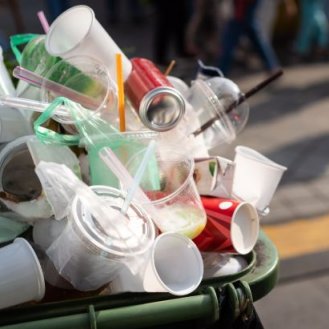
 Governments and organizations worldwide are enacting legislation to reduce plastic waste, driven by the environmental impact of single-use plastics.
Governments and organizations worldwide are enacting legislation to reduce plastic waste, driven by the environmental impact of single-use plastics.
Oct. 22, 2024 (Two Sides North America - Blog Post) - The push to reduce single-use plastics in packaging has gained momentum as companies respond to growing pressure from legislation, corporate sustainability goals, and shifting consumer preferences. Companies are largely moving towards alternatives like paper-based packaging, yet there are both benefits and challenges to this transition, particularly around recyclability.
Governments and organizations worldwide are enacting legislation to reduce plastic waste, driven by the environmental impact of single-use plastics, which contribute to pollution, climate change, and harm to wildlife. For example, recent U.S. policies aim to limit plastic pollution, reflecting a broader trend of regulatory action against single-use plastics.
The U.S. federal government is the largest buyer of consumer goods in the world. A report released by the administration in July detailed the administration's plan to phase out federal purchases "of single-use plastics from food service operations, events, and packaging by 2027, and from all federal operations by 2035." The report says this action could significantly impact the supply of plastic products, while the government seeks tougher regulations on plastics manufacturers.
Corporations are also setting ambitious sustainability targets, with many committing to reducing or eliminating plastic in their packaging. CPG giants Nestlé, Unilever, Procter & Gamble and L'Oréal have all recently switched to paper packaging for various lines of cosmetics and food items, or removed plastics from current paper packages. Consumer demand plays a critical role here; Two Sides North America research indicates that 55% of consumers would prefer to buy from brands that remove plastic from their packaging.
Environmental Appeal: Paper-based packaging is often seen as more eco-friendly than plastic because it is derived from renewable resources and is recyclable and biodegradable. Dole's recent packaging redesign of its smoothie bowls, which prominently features paper-based materials, highlights how brands can leverage these benefits to meet consumer expectations for sustainability. The new packaging design reportedly eliminates 97% of the plastic from the products' packaging.
Consumer Preference: Data from TSNA shows that consumers increasingly view paper as a better environmental option compared to plastic. About 66% of respondents favored paper/cardboard packaging over other materials for its perceived environmental benefits [3]. Consumers also preferred paper packaging because of the perception that it can be composted at home, recycled more easily, and is safer to use.
Corporate Sustainability Goals: Moving to paper helps companies align with their sustainability targets and reduces the carbon footprint associated with their products. For example, Dole estimates that switching to paper packaging for its smoothie bowl product line will eliminate 130 metric tons of plastic from its operations annually, supporting the company's sustainability goal of moving to zero fossil-based plastic packaging by 2025. Thousands of global companies have similar stated goals.
Recyclability Issues: Paper is generally more recyclable than plastic, but?not all paper-based packaging is created equal. Items like coated paper or those with mixed materials can complicate the recycling process, making it less efficient and more costly. Companies like Amazon have faced challenges in making their flexible, recyclable mailers widely accepted by municipal recycling programs, highlighting the challenges faced by the current recycling infrastructure.
Durability and Performance: While paper-based materials offer environmental benefits, they sometimes lack the performance characteristics of plastic, such as moisture resistance, safety and sanitation, or structural integrity. For instance, some ice cream brands have opted for plastic over paperboard packaging due to better performance in preserving product quality, and easier recyclability.
The movement away from single-use plastics in packaging is a complex but necessary step toward a more sustainable future. While paper-based packaging presents a promising alternative with distinct environmental benefits, companies must navigate challenges around recyclability, performance, and cost. As consumer preferences continue to shift, and legislation tightens, the packaging industry will need to innovate and adapt to meet the demands of a more eco-conscious market.
Two Sides North America is part of the non-profit Two Sides global network which includes more than 600 member companies across North America, South America, Europe, Australia and South Africa. Member companies span the Graphic Communications and Paper-based Packaging value chain, including forestry, pulp, paper, paper-based packaging, chemicals and inks, pre-press, press, finishing, printing, publishing, envelopes and postal operations.
Two Sides' goal is to dispel common environmental misconceptions and to inspire and inform businesses and consumers with engaging, factual information about the environmental sustainability and value of print, paper and paper-based packaging.
SOURCE: Two Sides North America
Paper Industry Newsletter
Stay on top of paper industry news
from around the world with
PaperAge's free weekly newsletter.
Delivered every Thursday.
Sign up today!